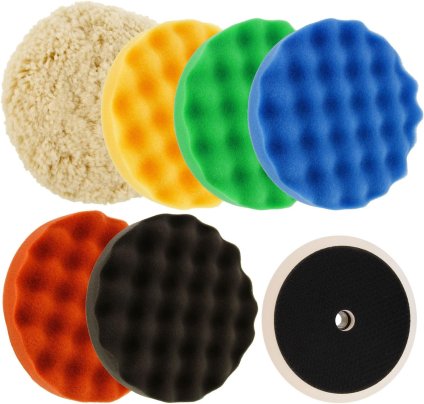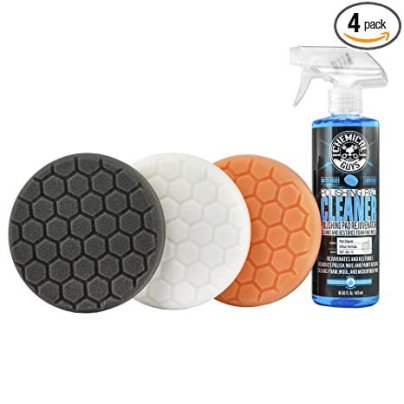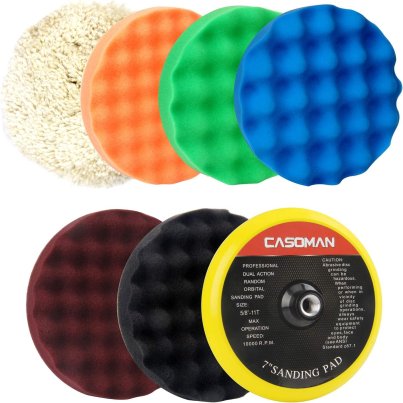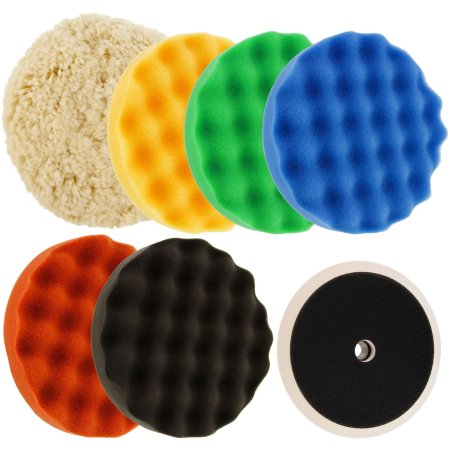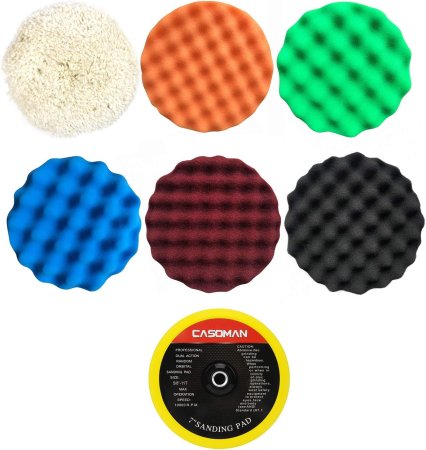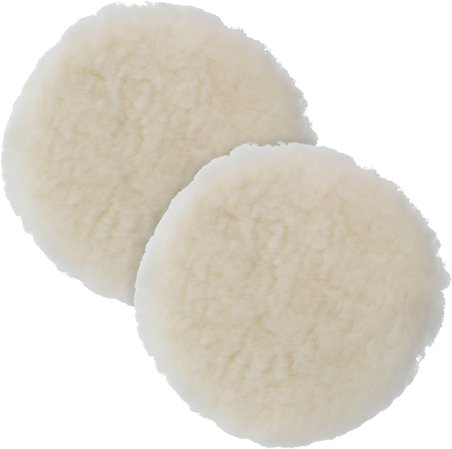We may earn revenue from the products available on this page and participate in affiliate programs. Learn more ›

Car care can be a rewarding yet frustrating experience. Especially when it comes to advanced detailing techniques like buffing a car. There are countless brands, colors, materials, and sizes of buffing pads—which do you choose? In this guide, we’ll give you the information and tools you need to make an informed decision when it comes to purchasing buffing and finishing pads.
Summary List of Best Buffing Pads
- TCP Global 8-inch Buffing Kit
- Chemical Guys 6.5″ Buffing Pad Kit
- CASOMAN 7-Inch Buffing and Polishing Pad Kit
- Cubitron II Finesse-It Buffing Pad
- TCP Global 7″ All Natural Premium 100% Wool Buffing Pad
Best Buffing Pads Reviews & Recommendations
Best Overall
TCP Global 8-Inch Buffing Kit
Pros
- Quick-and-easy identify which pad you need for the corresponding process
- Great size pad that’s easy to attach
- The variety of pads makes no buff job hard to tackle
Cons
- Takes more financial and instructional investment than other choices
- Takes practice to get the hang of what each pad does
Best Value
Chemical Guys 6.5-Inch Buffing Sampler Kit
Pros
- Pad design works great across straight and curved surfaces
- Cleaning solution makes swapping pads in the future a breeze
- Affordable
Cons
- Might not produce the best results for time invested
- For newbs only—pros might require a bit more
Honorable Mention
Casoman 7-Inch Buffing and Polishing Pad Kit
Pros
- Lightweight and easy to assemble
- Flexible yet durable
- Good price
Cons
- Sheds fibers over time which can make a mess
- Users have reported the wool pad prematurely falling apart
Honorable Mention
Cubitron II Finesse-It Buffing Pad
Pros
- 3M attachment system is fast and secure
- super-soft wool nap helps it conform and wrap around the curves of your car
- The best of the best
Cons
- Price
- For professional-level tool-use only
Honorable Mention
TCP Global 7" All Natural Premium 100% Wool Buffing Pad
Pros
- Price
- Conforms to car really well
- Produces a deep shine with ease
Cons
- Requires top-pro-level tools to get the full benefit
- Don’t last as long as most synthetic materials
- Drawstring tie can wobble off
Final Thoughts
TCP Global’s 8 Inch Buffing Kit with 6 Pads and Backing Plate is our best overall pick because of the value and utility the whole package offers for the price. The Chemical Guys 6.5 Inch Buffing Sampler Kit is our budget pick. With three pads and a bottle of cleaner, all you need is the dual-action or rotary polisher to start.
Buffing Pads FAQs
Q: When should I replace my buffing pads?
A. It’s easy to run your buffing pad a bit too close to sharp edges when buffing a car, especially if you’re tired. However, if you remove large amounts of the pad during use, replace the pad before you buff another car. If the pad surface is pockmarked, replace it as soon as possible.
Q: Are there certain pads that are better for black/dark-colored cars?
A. The answer to this question depends on what steps in the buffing process you want to do. In general, if you want like-new paint, you’ll need to begin with coarser compound buffing pads and then work your way to polishing and waxing. This is especially true for black and dark-colored cars where scratches are more easily seen.
Q: What are some key buffing pad features and differences?
A. Pad Size. Purchasing the correct pad size for your platform is key. Some rotary and dual-action machines will accept various sizes of pads via interchangeable backing plates. If you have to make the choice between a smaller or a larger buffing pad than the size recommended for your platform, it’s best to go with a larger one.
Pad Shape. Buffing pads are circular, but some pad faces are shaped in different ways. Waffle pads are used for extending the buffer’s reach into the valleys of the car’s body lines; honeycomb pads allow for distribution of air during the buffing process, and smooth/flat pads are used for polishing and finishing to achieve a mirror-like effect.
Type/Material. It’s important to understand what type of pad you need for the various buffing processes involved in correcting automotive paint. Cutting pads are typically denser to handle the intense heat and friction needed to repair deep scratches. Polishing pads are light and flat. Don’t attempt to use a pad for any other process than what it’s designed to do.
Q: What should I expect to pay for buffing pads?
A. $5-$10: Most 3-inch pads come in a variety pack at this price range. There are some 5.5-inch and/or 6.5-inch buffing pads in this price range as well, but they’re not the best quality. You can also purchase backing plates separately in this price range.
$11-$20: This is a good range to start with to determine what buffing pads you like and which ones aren’t working for you. You’ll find some name-brand pads here, but single pads of various types will usually be in this range. Backing plates are typically included with a pad or pads in this price range as well.
$21-$100: As with most of our top picks, you’ll find both value and variety in this price range. Single pads are priced at the lower end of this range, while kits run higher. Most kits will include a backing plate and at least three buffing pads of different types.
Q: How many buffing pads do I need to start out?
A. One buffing pad will suffice. Realistically, though, you’ll want to invest in a cutting pad, a polishing pad, and a waxing pad, all six to six and a half inches. We recommend you stock your buffing cabinet with these three basic pads to start out.
Q: What’s the best way to clean buffing pads?
A. Removing compound is easiest when it’s wet. Directly after you have finished with a buffing pad, place it in a bucket of hot soapy water. The soap can be your car wash soap or a simple dish soap you’d find at your local grocery store. Agitate the pads with your fingers to remove the stubborn compound and allow it to air dry before using it again.
Q: What are the benefits of using buffing pads?
A. Buff your own car. Buffing your own vehicle is easier than you might think. You can easily kit yourself out with a starter kit for less than you might spend on having a professional buff your car for you.
Give a gift to the DIY auto enthusiast in your life. Whether it’s for a birthday or Christmas gift—or “just because”—supporting someone’s automotive hobby is a great feeling. Doing your research may help you score brownie points, too.
Do your own paint correction. You change your own oil, replace the brakes on your car yourself, and generally spend most of your time in the garage. Add buffing to your skills list by investing in a starter kit or the supplies you need to keep your ride in tip-top shape.
Try out a new tool. Automotive paint correction will be around as long as there are cars on the road; just like the vehicles around us, techniques continually evolve. It never hurts to try a new method because you can always go back if necessary.
Get the right tool for a professional shop. Whether you know what brand(s) you like or are looking to try out a few systems, you’re going to have to stock your shelves with paint-correction materials like rotary buffers, buffing pads, dual-action polishers, orbital polishers, and more. Invest in proven materials to increase efficiency and impress your customers.
Q: Please, my friend, what are some tips for using buffing pads?
A. Practice buffing on less-than-stellar paint at first. With anything else, you’ll probably make a few mistakes along the way before you get into the best polishing practices; it’s best to do that on a car you don’t really care about. A good pad kit also helps with getting the basics down.
Start out your buffing experience with wet waxing. You can use a wax on the clear coat from your local auto parts store and a flat foam pad. To get the basics of machine polishing down, set your rotary polisher to 1,400 RPMs and apply four dots of a nickel-sized amount of wax in a diamond-shaped pattern on the pad itself. Use a microfiber towel to help with controlling messes.
Wax is easier to work with than cutting or polishing compound. It’s the same consistency, but it won’t necessarily create a haze or swirl marks in your paint after use. Beginners should buff with wax first since you’ll quickly learn how not to slop wax everywhere and how the buffing pad and paint react to one another.
Experiment with different buffing pads, rotary buffers, orbital buffers, paint colors, etc. Tape off two 2-by-2-foot sections next to each other on the hood. Perform your buffing processes to one section but not the other and visually compare your before and after. Darker colors will show more dramatic results, unlike silver and white cars. Stick with pads that get you the results you want.
Reading the instructions for using various compounds, polishes, and waxes, as well as buffing pads, is key to getting the most out of your machine, your buffing pads, the compounds, and your time/effort. Use the instructions as guidelines.
While some pads can be used for both compounding and polishing (given you clean the pad between processes), it’s better to get two separate pads for each process. That way if you have to go back and compound something you might have missed, you don’t have to clean the same pad four times.
Q: How hard should I press when using buffing pads?
A. Buffing machines are meant to create the heat and friction necessary to activate the compound, whether you’re compounding, polishing, or waxing. That’s why you can adjust the RPMs manually. The only pressure you need to apply is enough to maintain constant and consistent pressure across the surface of the pad. It’s about the same amount of pressure required to hold a pencil or press a button.
Q: Can I mix and match buffing pads and compounds?
A. This is something we advise only professionals or those with a few years of experience under their belt should do. You may end up damaging the paint, your pad, and/or your machine if you don’t use the proper combination.
Q: Do I need to wipe off excess compound right away?
A. Yes, it’s best to get rid of the compound when it’s wet, either on the car or on your buffing pads (or on you). Water on a microfiber cloth works well for door jambs, but it’s best to use a soft microfiber cloth that’s been conditioned with a bit of spray wax. It’s less likely to scratch your just-buffed paint while still removing built-up compound.
